
Increased muscular workload does not lead to aggravated cardiac dysfunction in nexn knockout zebrafish. (a) nexn+/+ and nexn−/− embryos do not show significant differences regarding responsiveness to mechanical stimuli at 48, 72 or 120 hpf (N = 3, mean ± SD, p > 0.9999 for all using Mann–Whitney test). (b) Maximal velocity was not affected at any developmental stage after increasing workload (N = 3, n = 15, mean ± SD, 48 hpf: p = 0.7875, 72 hpf: p = 0.5428, 120 hpf: p = 0.5202 using two-tailed t-test). (c) Maximal acceleration is at a similar level in nexn+/+ and nexn−/− embryos at 48, 72 and 120 hpf (N = 3, n = 15, mean ± SD, 48 hpf: p = 0.2460, 72 hpf: p = 0.1754, 120 hpf: p = 0.9284 using two-tailed t-test). (d) Heart rate of nexn−/− embryos was at a similar level as in nexn+/+ embryos at 48, 72 and 120 hpf (N = 3, n = 15, mean ± SD, 48 hpf: p = 0.1738, 72 hpf: p = 0.3121, 120 hpf: p = 0.8520 using two-tailed t-test). (e) Increased workload does not affect enddiastolic ventricular diameter at 48 and 72 hpf (N = 3, n = 15, mean ± SD, 48 hpf: p = 0.1807, 72 hpf: p = 0.4152 using two-tailed t-test) but leads to increased enddiastolic diameter at 120 hpf (N = 3, n = 15, mean ± SD, p = 0.0017 using two-tailed t-test). (f) Analysis of ventricular fractional shortening does not show altered heart contractility in nexn−/− compared to nexn+/+ embryos at 48 hpf (N = 3, n = 15, mean ± SD, p = 0.1538 using two-tailed t-test) but reduced fractional shortening at 72 and 120 hpf (N = 3, n = 15, mean ± SD, 72 hpf: p = 0.0379, 120 hpf: p = 0.0020 using two-tailed t-test). FS fractional shortening, ns not significant, *p < 0.05, **p < 0.01. Exact values (mean ± SD) are shown in Supplementary Table 1.
|

